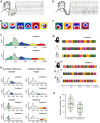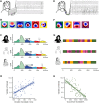EEG Microstates in Social and Affective Neuroscience
- PMID: 37523005
- PMCID: PMC11199304
- DOI: 10.1007/s10548-023-00987-4
EEG Microstates in Social and Affective Neuroscience
Abstract
Social interactions require both the rapid processing of multifaceted socio-affective signals (e.g., eye gaze, facial expressions, gestures) and their integration with evaluations, social knowledge, and expectations. Researchers interested in understanding complex social cognition and behavior face a "black box" problem: What are the underlying mental processes rapidly occurring between perception and action and why are there such vast individual differences? In this review, we promote electroencephalography (EEG) microstates as a powerful tool for both examining socio-affective states (e.g., processing whether someone is in need in a given situation) and identifying the sources of heterogeneity in socio-affective traits (e.g., general willingness to help others). EEG microstates are identified by analyzing scalp field maps (i.e., the distribution of the electrical field on the scalp) over time. This data-driven, reference-independent approach allows for identifying, timing, sequencing, and quantifying the activation of large-scale brain networks relevant to our socio-affective mind. In light of these benefits, EEG microstates should become an indispensable part of the methodological toolkit of laboratories working in the field of social and affective neuroscience.
Keywords: Affective neuroscience; EEG microstates; ERP microstates; Neural networks; Social interaction; Social neuroscience.
© 2023. The Author(s).
Conflict of interest statement
The authors declare that they have no conflict of interest.
Figures




References
-
- Antonova E, Holding M, Suen HC, Sumich A, Maex R, Nehaniv C. EEG microstates: functional significance and short-term test-retest reliability. Neuroimage Rep. 2022;2:100089. doi: 10.1016/j.ynirp.2022.100089. - DOI

